ON THE FLOOR
Mike Sweeps the Floor
 By MIKE PASINI
By MIKE PASINIEditor
The Imaging Resource Digital Photography Newsletter
ORLANDO, Fla. -- After a press room breakfast of tooth-crushing bagel and boiling oil coffee, we stumbled over to the trade show floor, our sleeves rolled up and our digicam asleep to see what all the fuss was about.
Six hours of hiking later, we've returned to our penthouse digs in Orlando to write it up for you. But we'll be writing up today's report in spurts, adding to between naps. There's a fine line between fact and fiction, we found out on the floor, and only by dreaming a bit can we properly represent it here.
We weren't dreaming, however, when we ran into the Imaging Resource video team. Dave has ramped up our video coverage significantly this year. Here they are before the floor opens to the public working the Kodak booth.
In the top picture Publisher Etchells (left) is chatting with Kodak's Michael DeLuca prior to interviewing him. Videographer Andrew Alexander in green and Camerman Luke Smith prepare for the shot.
In the bottom shot, the interview is in full swing. Andrew makes notes while Luke films Dave's chat with Michael. The topic? A Tour of Kodak Imaging Sensors.
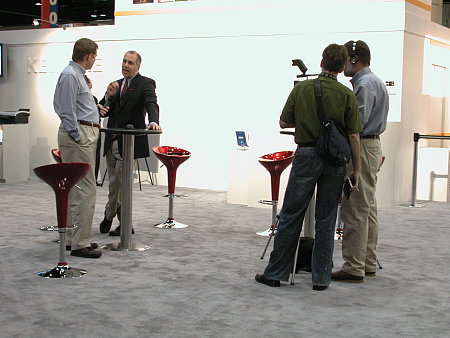 |
| The IR Video Team |
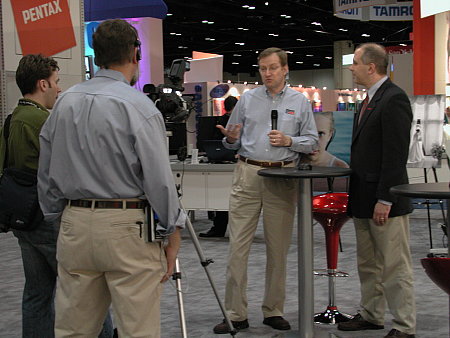 |
| In Action |
SOME BOOTHS | Back to Contents
Our warm-up lap revealed a few noteworthy booths. A few that caught our eye include:
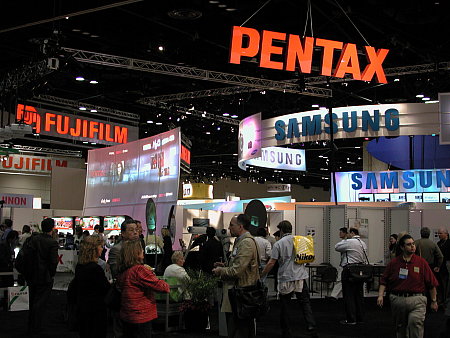 |
| The Convention Floor |
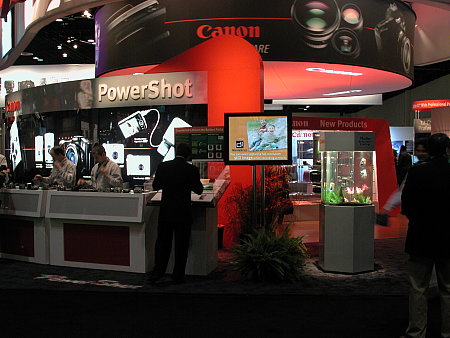 |
| Canon |
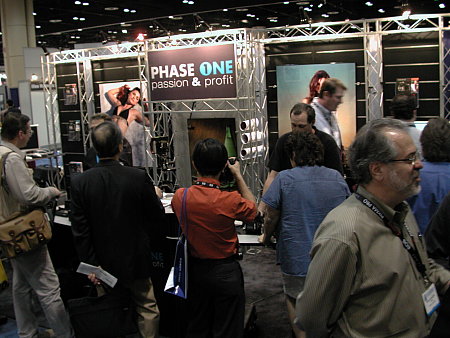 |
| Phase One |
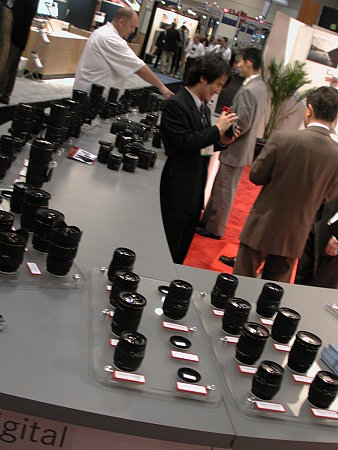 |
| Sigma Glass |
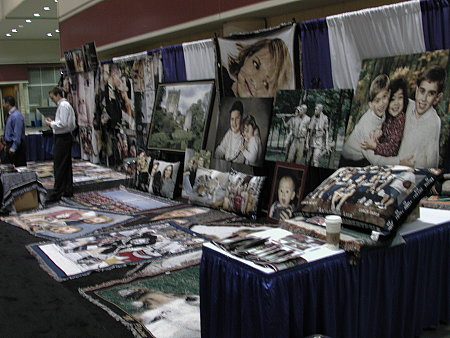 |
| Rugs |
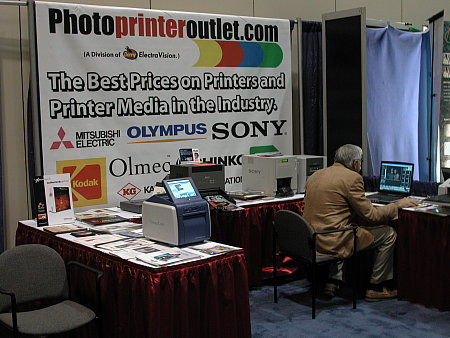 |
| Apparently there's an outlet for everything |
GITZO MONOPOD | Back to Contents
Kyle Kappmeier took pity on us at the Gitzo booth, offering us the new Gitzo Traveler monopod to lean on. It uses a new, 30 percent lighter weave of six strands of carbon fiber. We picked it up and thought we dreaming again -- it has almost no weight. You aren't sure there's anything in your hand at all. Less than a pound, the specs say.
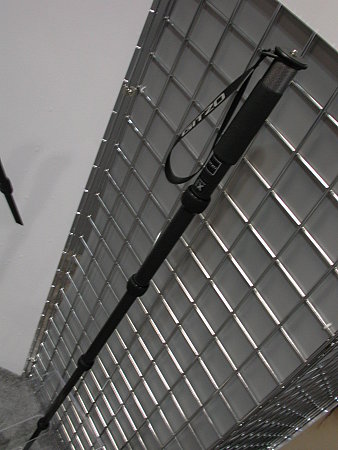 |
| Gitzo's New Monopod |
Fold it up and it's just 14.3 inches long. One quarter twist of the neatly tucked grips extends all six sections to 56.1 inches, ready to bear up to 9.9 lbs. Which we somewhat exceeded.
Our first serious business of the day was a tour of Mitsubishi's pro dye sub line, which runs a bit under $3,000. They're popular with event photographers and tend to be the machine in the kiosk that does the dirty work.
Product Manager Margie Chiaramonte told us the company has been building dye sub printers for nearly 25 years, selling them to other companies to relabel as their own.
They offer both the standard glossy finish and a mat finish, created mainly by the ribbon, not the paper. And the paper comes in rolls, which explains the bulky size of the printers. About 600 4x6 prints a roll.
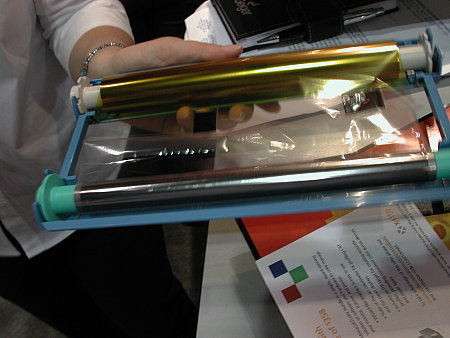 |
| The Cartridge |
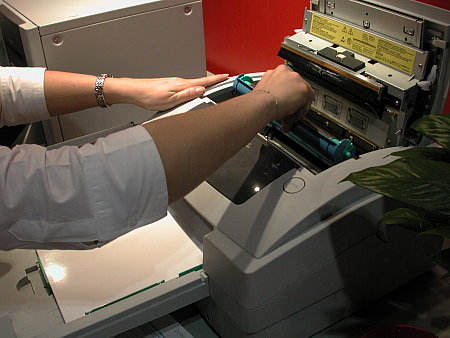 |
| Installing the Cartridge |
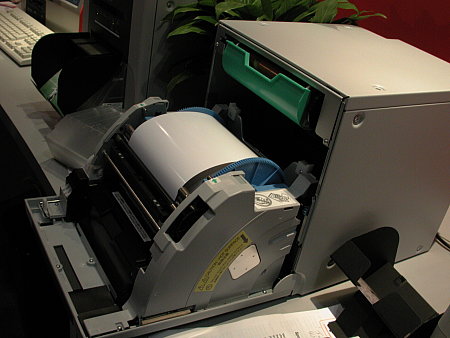 |
| Paper Roll |
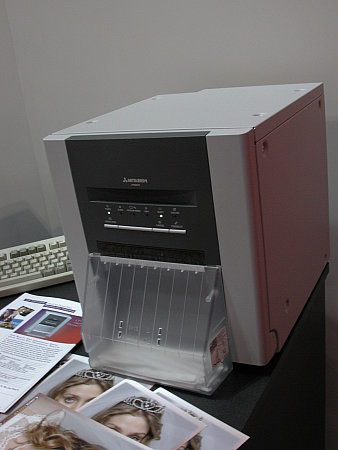 |
| The 600 dpi version |
The CP9550DW is warranted to make 20,000 prints (4x6, 5x7, 6x9) on its original 346-dpi printhead. A USB printer, it includes all the software you need to edit and print images. If anything happens to it, the company will ship you refurbished unit within 24 hours under its Express Replacement program.
The company is about to ship the CP9600DW, which ups the continuous tone resolution from 346 to 600 dpi, among the highest in the industry.
We asked Margie about the longevity of dye-sub prints and she groaned. The Wilhelm Institute reports it at about 4-7 years, but she doesn't buy it. She said Mitsubishi simply says dye sub is comparable to the silver halide prints customers are used to getting. Keep them in a shoebox and dye sub prints will last 25 years, too.
We ran across the $96 Lensbaby 2.0 at Pepcom and mentioned in our Friday report. But we finally stopped by the booth to get a closer look.
It's a "selective focus" lens for your dSLR, which means you can control how much and which part of the scene is in focus by squeezing the lens into its bellows extension. Fully extended, the Lensbaby is focusing about 12 inches ahead. As you pull in, and bend the flexible extension, you change focus and move the lens's sweet spot around.
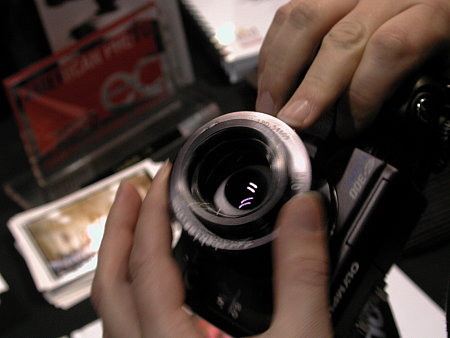 |
| Lensbaby 2.0 |
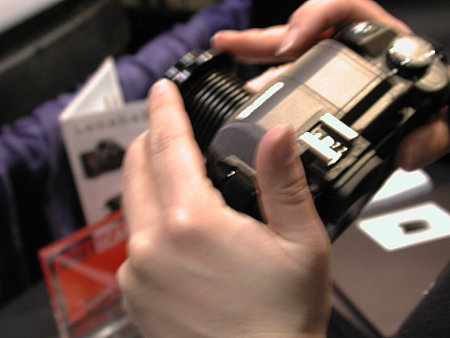 |
| Lensbaby in Action |
To increase the size of the sweet spot, you change aperture rings. These are nothing more than black magnetic washers. A complimentary mini Lenspen lifts the installed aperture ring out and you simply drop another in.
The lens itself is a coated, high refractive index, low dispersion, optical glass doublet that is about a 50mm equivalent. A macro kit can get focus as close as two to three inches away.
When we tried it, we found it easy (and fun) to use. Certainly a trick up any professional photographer's sleeve.
We caught up with Victor Sazhin at the VicMan booth where he was doing demos of his newly-released $29.95 Photo Toolkit for Windows (http://www.photo-toolkit.com). The toolkit integrates directly into Windows Explorer, popping up under the Image & Fax Viewer toolbar to provide image editing options. It can also function as a stand-alone application.
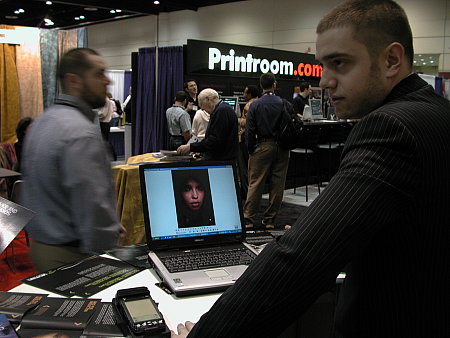 |
| VicMan's Victor Sazhin |
Among the operations available is Red Eye Remover, an automatic red-eye removal that does not require you to do anything more than click its button. It's right 90 percent of the time, Victor told us. For the rest, you just draw a marquee around the eye and it automatically removes the red, desaturating and darkening the pupil. There are faster red-eye removal tools, Victor admitted, but none as good at detection and correction.
The VicMan Makeup plug-in makes it easy to correct skin imperfections. Several brush tools, each addressing a specific skin defect, approximate neighboring areas to overcome the defects, making the skin look natural and smooth.
Photo Toolkit also contains a unique technology for whitening teeth without precise brush strokes. Based on "advanced statistical processes," the tooth whitening brush preserves the color of the lips and whitens only the teeth.
The advanced Color Correction module provides levels, contrast and gamma correction, either automatically or using more advanced methods, like automatic saturation correction and illumination flattening.
The red-eye and teeth whitening plug-ins rely on cybernetics, Victor told us. VicMan trains the algorithms in their lab and distributes the "educated" algorithms in the final product. Algorithms without training just don't perform as well, he said.
He also showed us My Pictures 3D, which can create an animated three dimensional gallery of images in your My Pictures folder. You can use it as a screen saver or to create a self-running slideshow.
VicMan has also developed a patent-pending software distribution method that allows original equipment manufacturers to install Photo Toolkit in their cameras. Camera owners just have to plug their cameras into a computer that uses any Windows operating system to launch the software. No other installation or activation is required.
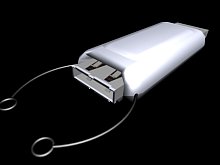 |
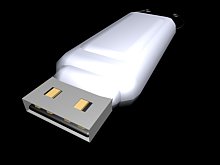 |
|
| VicMan USB Device Mock up of a portable application player (Images courtesy of VicMan) |
||
In fact, Victor said VicMan is developing a small USB hub with a flash drive to host the applications. Plug a digicam into the hub and the hub to a computer and you can access both the digicam and the flash drive loaded with Photo Toolkit and anything else you want to store on it.
We danced over to the Lexar booth to find out more about this plug-in for Bridge we learned about last night at Adobe's reception.
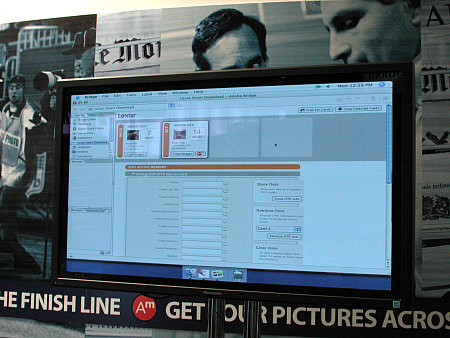 |
| The ActiveMemory Plug-in |
There's a small catch. The plug-in only works with Lexar's ActiveMemory CompactFlash cards. That's because only those cards have a reserved location on the card that is not overwritten when it is reformatted. That ActiveMemory location is where a photographer can store IPTC metadata which can be read by the plug-in and written to each image as it is being stored on the computer.
A couple of things caught our eye at the Sony booth.
The $299 Sony Digital Photo Album is an 80-GB box with a card reader designed to store every image you'll ever take. A USB 2.0 port makes it possible to back up this precious collection and it offers HD output with a remote control, too.
 |
| The Sony Digital Photo Album |
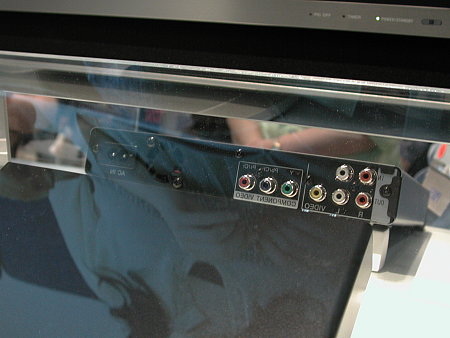 |
| Ports |
What disturbed us about the product, however, was the problem of retrieving 80 years of images. Built into the player is a calendar display of your images, so if you know when an image was taken, you can retrieve it. This seems far too simple for practical use.
If you're going to store a lifetime of images in a box other than your computer, you'll need a sophisticated digital asset manager to look for and retrieve those images. Sony simply hasn't delivered that in this product.
More interesting was Sony's least expensive digicam, the S600. For just $200 you get a 3x Carl Zeiss lens, 32-MB internal storage with a Memory Stick slot for more, a 6.0-Mp sensor and a two-inch LCD (well, you can't have everything) running on AA batteries. That seems like quite a bargain.
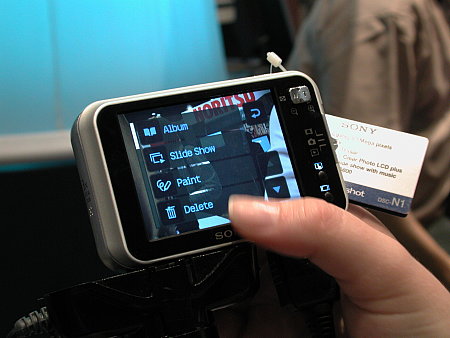 |
| New Touch Screen Interface |
We spent 15 minutes at the Imagenomic booth with Chief Operating Officer Art Ghazaryan and CEO David McDonell. Art walked us through a demo of Noiseware, the company's innovative cross-platform approach to minimizing luminance and chrominance noise.
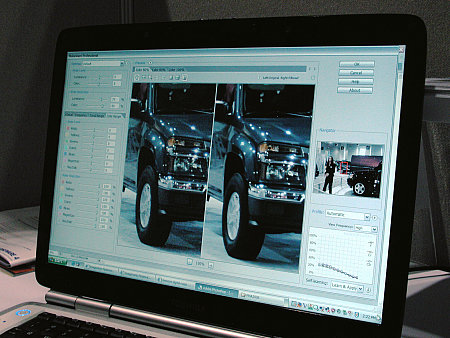 |
| Noiseware |
The innovative thing about Noiseware is that it doesn't need a camera noise profile, like nik Software's Dfine, for example. Instead, it analyzes the image itself to detect both types of noise. And despite taking that extra step, Art said, it's faster than its competitors Noise Ninja and Dfine (four seconds to process a 16-bit 8-Mp image).
They spent about six to nine months working on just the patented algorithms themselves. And yes, they are self-learning, he said. They even learn when to train themselves. And you can step in any time to tell them to ignore an oversharpened image, say.
Art took the noise out of an ISO 1600 8-Mp image with one click. Presets let you tell Noiseware what kind of subject it's dealing with. For example, a landscape would have a lot more detail than the polished fender of a classic car.
It also has a DetailGuard command to tell it how aggressive to be in both noise detection and noise removal. And you can bracket the results, too.
You can also sample up to 10 non-contiguous regions of the image to clue in Noiseware to the problem.
Noiseware is available as a Photoshop plug-in for Mac and Windows, in a mobile edition for camphones and in a software development kit for developers.
We dropped by the O'Reilly booth just as Mikkel Aaland was accosting Bill Yates, one of eight or nine actual newsletter subscribers. We leaped to his aid by taking a photo of the attempted assault. Mikkel saw us, naturally, and pointed an accusing finger. "Me?! You're the one who's dangerous," he yelled at us. "One more sentence out of you might have killed him!"
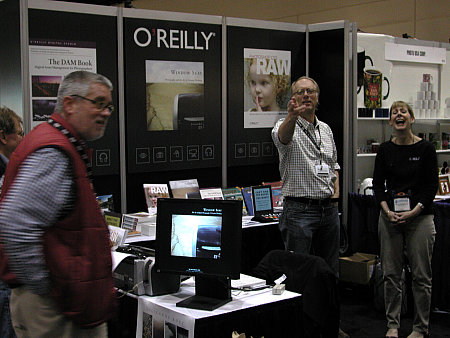 |
| The O'Reilly Booth Aakland attacks subscriber Yates |
Mikkel was there to promote Photoshop CS2 Raw. We'd asked him earlier how it compares to Bruce Fraser's book on the same subject. "Good question," he stalled. "They're complementary," he explained. Bruce's work deals with the technical aspects of Bridge and Camera Raw and DNG and Raw files whereas his is a more casual approach to the power of Raw imaging. News editor Michael Tomkins stole a copy for us, so we'll find out for ourselves and review it in the newsletter.
We didn't have to steal Julieanne Kost's new book from O'Reilly, Window Seat: The Art of Digital Photography and Creative Thinking. When we spoke to her earlier about it, she described it as the story of how to do a personal project. It's really a three-part book. It begins with a list of ways to stay creatively alive that is more practical than inspirational (which we mean in a good way, you know). Then it moves right in to a portfolio of photographs Julieanne took through the window of one airliner or another, with commentaries describing her experiences and thought process. Finally, it concludes with a technical section that explains how the images were shot, manipulated, and prepared for printing without describing every little keystroke.
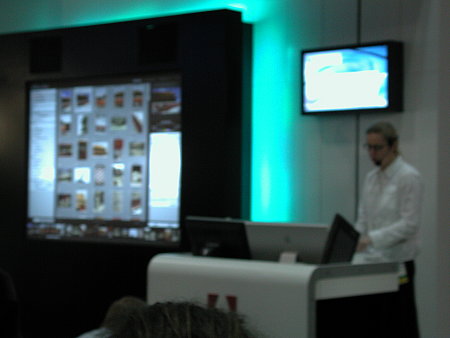 |
| Julieanne Elucidates Lightroom |
Peter Krogh is also lurking around the booth during the show to promote his The DAM Book, which we did review in our Dec. 9, 2005 newsletter (http://www.imaging-resource.com/IRNEWS/index-arch.html").
We took a break from our hike to listen to Kodak Senior Vice President Phil Faraci in the second day keynote. He made two points that struck home to us.
The first of which was that there are, by company estimates, trillions of images hidden away in shoeboxes. Kodak has repurposed an industrial level scanner for labs to scan a client's lifetime collection of prints, writing a CD and a book of images. He told the story of a 70 year old named Joe who brought his shoeboxes in, got them scanned and went home -- fairly unimpressed -- with the CD and book to annotate the images. In two weeks he returned in tears, having reviewed his life image by image. "That was the first ballgame I attended," he told the imaging team.
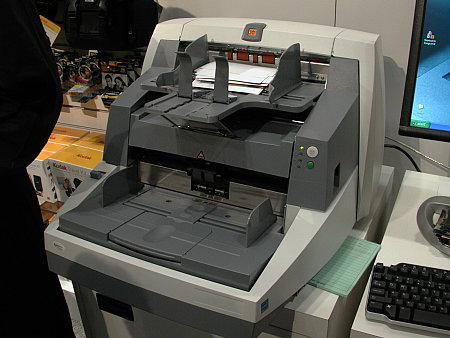 |
| The Memory Scanner |
The second point involved Kodak's partnership with Skype, although it wasn't entirely clear in just which way. The product, still just a prototype, is called Konga. And it's something of a photoblog. You instant messenger a few images and those who are receptive to them can add more images to the collection, which scrolls across everyone's screen as often as they like. A right click displays any of the images full screen and a double click opens the comment dialog so you can add text to any of the images.
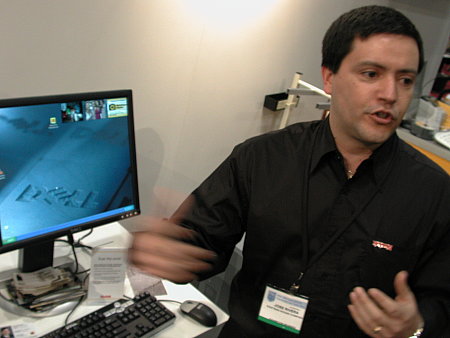 |
| A Konga Line Forms |
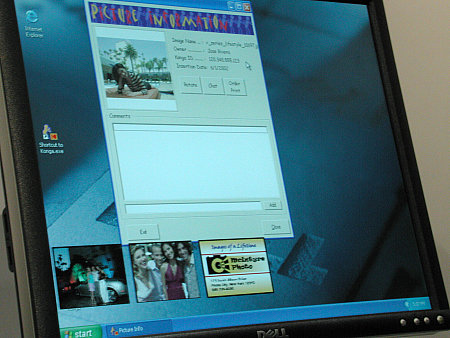 |
| And Keeps Dancing |
Each of these two technologies addresses what Faraci called the new digital ecosystem in which the customer sets the rules. The former deals with the trillions of legacy images that exist only as prints. And the later deals with the often ephemeral imaging we see today in the camphone culture. By 2010, Faraci predicted, everyone will be carrying a camera with them, most likely a camphone, capable of taking credible snapshots if not quite the right tool for special occasions.
WAYNE'S WORLD | Back to Contents
Finding Konga at the Kodak booth (as Faraci had invited us to do) was no small matter. We tapped into our most secret contacts at Kodak to get a demo and some screen shots (above).
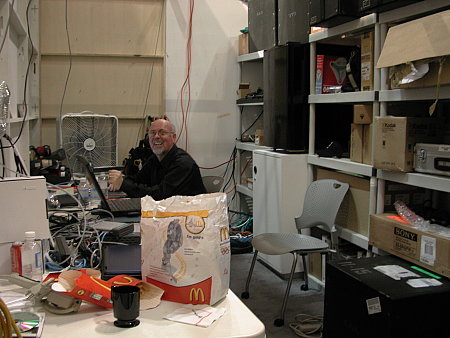 |
| The Wiz (aka Wayne Rogers) |
After Jose Rivera's demo, we were led through the looking glass, so to speak, to Wayne's world. On the other side of the big white wall that proclaims "Protect Us," Wayne actually does. Kodak's IT wizard Wayne Rogers was (legally) able to tap into the convention center's T1 line to support roughly 30 users. As long as he's sitting in the control room, anyway.